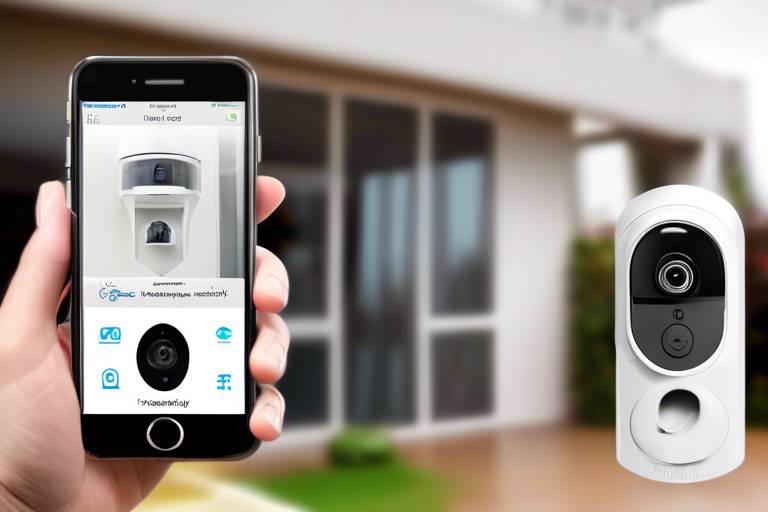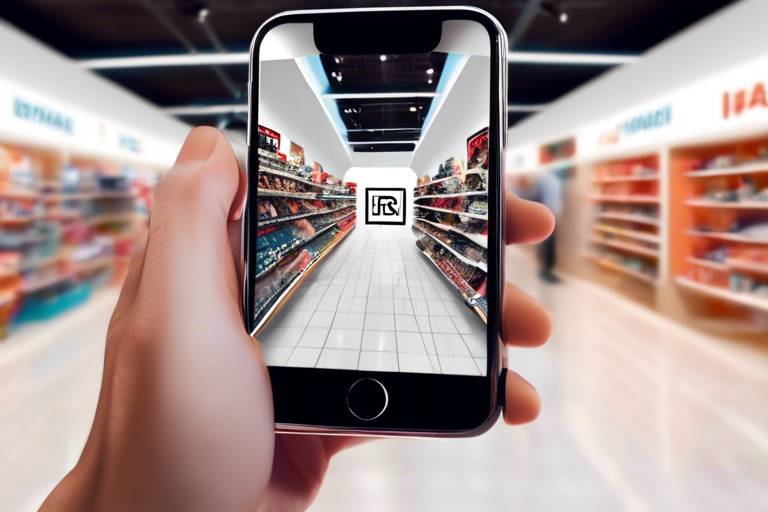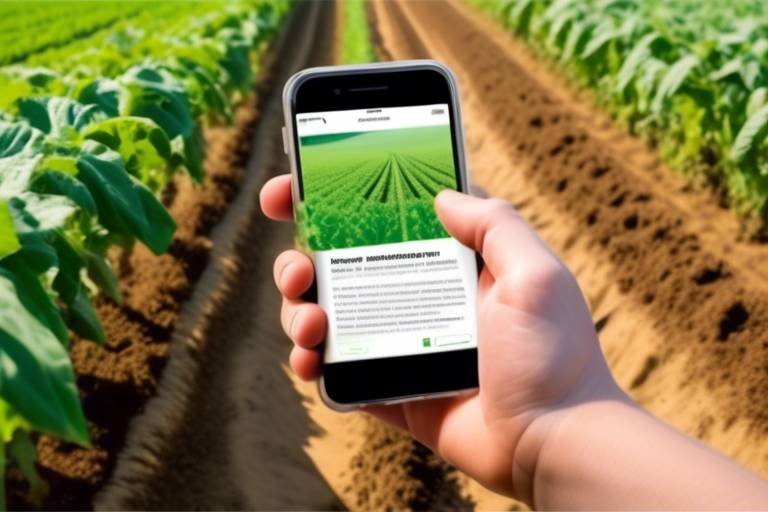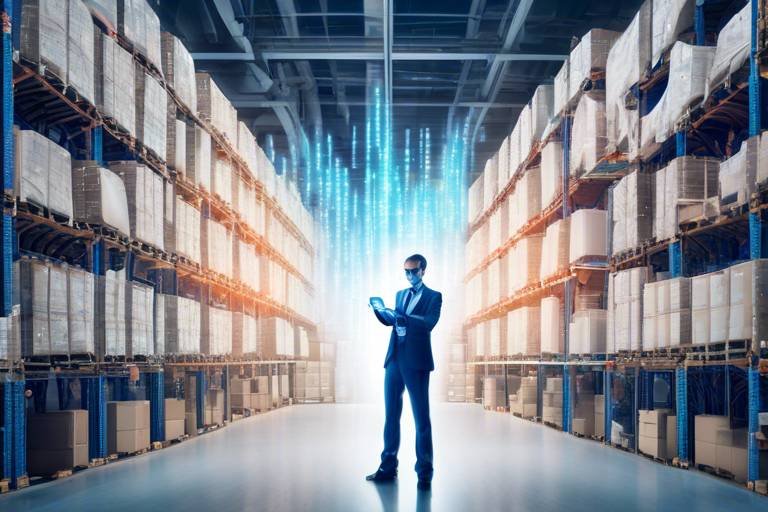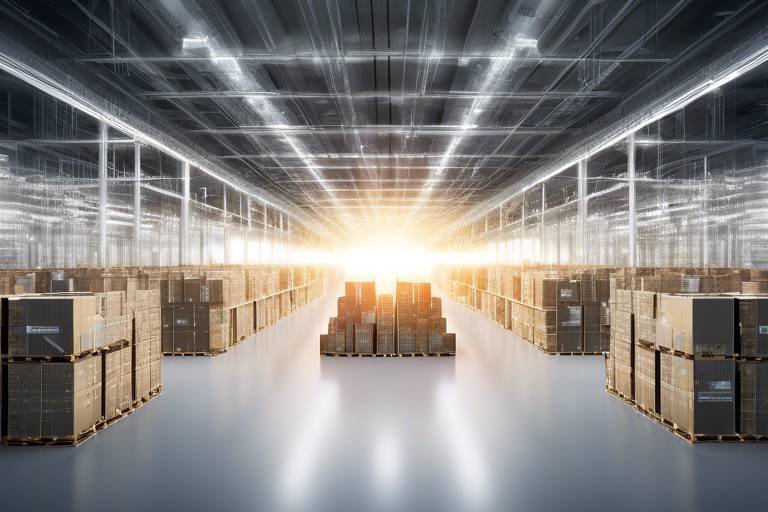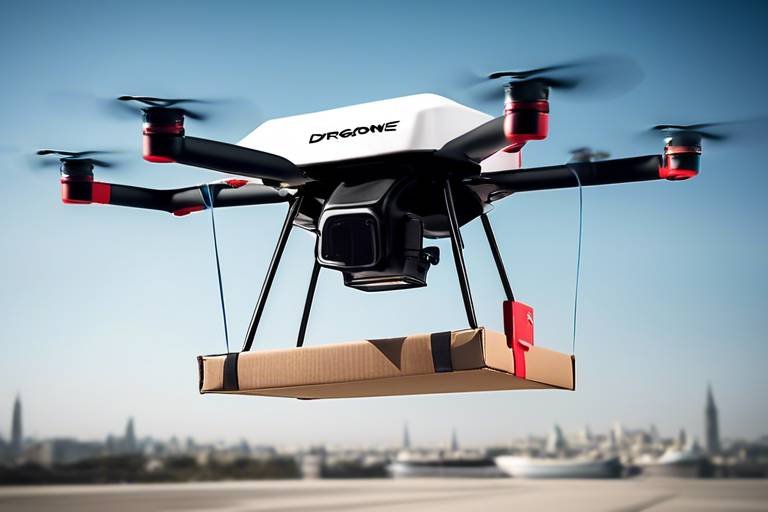How Blockchain is Improving Food Safety
In today's world, where food safety concerns are at an all-time high, blockchain technology emerges as a beacon of hope. Imagine a world where every bite you take is traceable, where the journey of your food from farm to table is transparent, and where the trust between producers and consumers is rock solid. This article delves into the transformative impact of blockchain on food safety, showcasing how it enhances traceability, transparency, and trust throughout the food supply chain. With the power of blockchain, we can revolutionize the way we think about food safety, making it not just a regulatory requirement but a fundamental right for consumers everywhere.
So, what exactly is blockchain technology? At its core, blockchain is a decentralized digital ledger that records transactions across multiple computers. This means that no single entity has control over the entire system, which significantly enhances security and reduces the risk of fraud. Each transaction is time-stamped and linked to the previous one, creating a chain of blocks that are virtually impossible to alter. When applied to food safety, this technology provides a robust mechanism for tracking every step of a food product's journey. From the farm where it was grown to the grocery store where it is sold, blockchain ensures that every piece of information is recorded and accessible.
Traceability is more than just a buzzword; it’s a critical component of food safety. It refers to the ability to track food products from their origin to the consumer’s plate. With blockchain technology, traceability becomes not only possible but incredibly efficient. Imagine being able to scan a QR code on your food packaging and instantly access its entire history. This level of transparency ensures that any food safety issues can be quickly identified and addressed. In a world where foodborne illnesses can spread rapidly, having a reliable traceability system is essential for protecting public health.
One of the most exciting aspects of blockchain is its ability to facilitate real-time tracking. This allows all stakeholders in the food supply chain—producers, distributors, and retailers—to monitor food products at every stage of their journey. For example, if a batch of lettuce is found to be contaminated, blockchain enables immediate action to be taken by tracing the product back to its source. This real-time data sharing not only enhances safety but also streamlines operations, reducing waste and improving efficiency.
Today's consumers are more informed than ever and increasingly demand transparency about their food sources. Blockchain technology empowers consumers by providing them with access to detailed product information. With just a simple scan of a barcode, a consumer can learn about the product's origin, the farming practices used, and even the conditions under which it was processed. This level of transparency fosters trust and confidence in the food they consume, making them feel more connected to the products they purchase.
Food fraud is a significant issue affecting safety, costing the industry billions each year. Blockchain's immutable records help combat food fraud by ensuring the authenticity of food products. When every transaction is recorded and cannot be altered, it becomes nearly impossible for fraudulent activities to go unnoticed. This level of security not only protects consumers but also supports honest producers who are committed to providing quality products.
Compliance with food safety regulations is crucial for businesses, and blockchain simplifies this process significantly. By automating record-keeping and reporting, blockchain reduces the risk of human error and improves accuracy for regulatory bodies. This means that businesses can focus more on their operations and less on navigating complex compliance requirements. Additionally, with blockchain, audits can be conducted more efficiently, further enhancing overall food safety standards.
To truly understand the impact of blockchain on food safety, let’s explore some real-world applications. Numerous companies have begun to implement blockchain solutions, resulting in tangible improvements in safety protocols and consumer trust. For instance, a well-known food retailer recently adopted blockchain technology to track its supply chain, leading to a significant reduction in food waste and a marked increase in consumer confidence.
Success stories abound in the food industry, showcasing how blockchain has enhanced safety and efficiency. Companies like Walmart and Nestlé have successfully integrated blockchain into their supply chains, allowing them to trace food products in seconds rather than days. This transformation not only protects consumers but also strengthens the brand's reputation and market position.
Despite its potential, blockchain faces challenges in adoption. The food industry must overcome several hurdles, including the need for standardization, the integration of existing systems, and the education of stakeholders about the technology. However, as more companies recognize the benefits of blockchain, these challenges will likely diminish, paving the way for a safer food supply chain.
- What is blockchain technology? Blockchain is a decentralized digital ledger that records transactions across multiple computers, ensuring security and transparency.
- How does blockchain improve food safety? It enhances traceability, reduces food fraud, and simplifies regulatory compliance.
- Are there any challenges to implementing blockchain in food safety? Yes, challenges include standardization, system integration, and stakeholder education.
- Can consumers access information about their food through blockchain? Absolutely! Blockchain allows consumers to trace the origins and journey of their food products.

Understanding Blockchain Technology
Blockchain technology is often described as a decentralized digital ledger that records transactions across multiple computers. This innovative technology ensures that the data recorded is immutable and transparent, which means once information is added to the blockchain, it cannot be altered or deleted. This feature is particularly important in the food industry, where trust and safety are paramount. By providing a secure method to track food products from their origin to the consumer's plate, blockchain offers a revolutionary approach to enhancing food safety.
At its core, blockchain operates on a network of nodes, each holding a copy of the entire ledger. When a transaction occurs, it is verified by the network and then added to a block. Once the block is filled, it is linked to the previous block, forming a chain of blocks – hence the name blockchain. This process not only secures the data but also allows for real-time updates, making it an ideal solution for industries that require constant monitoring and verification.
One of the most significant advantages of blockchain in food safety is its ability to enhance traceability. Imagine being able to trace a piece of salmon back to the exact farm it came from, or knowing the precise conditions under which it was stored and transported. With traditional systems, this level of detail can be difficult to achieve, often leading to gaps in information that can compromise food safety. However, with blockchain, every transaction – from farm to table – is recorded, allowing stakeholders to access a complete history of the food product.
Moreover, the transparency offered by blockchain means that all participants in the supply chain can view the same data. This shared visibility fosters trust among producers, distributors, retailers, and consumers alike. Each participant can verify the authenticity of the product, which is crucial in an industry plagued by issues like food fraud and contamination. By using blockchain, businesses can ensure that they are not only compliant with food safety regulations but also that they are providing their customers with the highest quality products.
In summary, blockchain technology is not just a buzzword; it is a game-changer for the food industry. Its ability to provide a secure, transparent, and immutable record of transactions has the potential to revolutionize food safety practices, ensuring that consumers can trust the food they eat. As we delve deeper into this topic, we will explore how these principles are applied in real-world scenarios, showcasing the transformative impact of blockchain technology on food safety.

The Importance of Traceability
Traceability is more than just a buzzword in the food industry; it’s a fundamental principle that ensures the safety and quality of our food. Imagine biting into an apple and knowing exactly where it came from, how it was grown, and whether it met safety standards. This is the power of traceability, and blockchain technology is revolutionizing how we achieve it. By utilizing a decentralized ledger, blockchain allows every stakeholder in the food supply chain—from farmers to consumers—to access critical information about food products in real-time.
When we talk about traceability, we’re essentially discussing the ability to track food products from the moment they are harvested until they reach our plates. This journey can be quite complex, often involving multiple producers, distributors, and retailers. Blockchain simplifies this process by creating an immutable record of every transaction, ensuring that every piece of information is accurate and cannot be altered. This level of transparency not only enhances food safety but also builds trust among consumers who are increasingly concerned about where their food comes from.
One of the standout features of blockchain technology in relation to traceability is its capacity for real-time tracking. Imagine a scenario where a food safety issue arises—say, a contamination outbreak. With traditional methods, it could take days or even weeks to trace back the source of the problem. However, with blockchain, stakeholders can instantly access the entire history of a food product, identifying the exact farm it came from, the processing facilities it passed through, and the stores it was shipped to. This rapid response capability is crucial in mitigating health risks and preventing widespread outbreaks.
Moreover, the importance of traceability extends beyond safety; it also plays a significant role in enhancing the overall quality of food products. Consumers today are not just looking for food that is safe; they want to know about the quality and sustainability of their food sources. With blockchain, producers can provide detailed information about their farming practices, such as whether they use organic methods or sustainable harvesting techniques. This level of transparency empowers consumers to make informed choices and fosters a deeper connection between them and their food.
In addition to consumer trust, traceability also aids in reducing food fraud, which is a growing concern in the industry. Food fraud can take many forms, from mislabeling products to selling counterfeit goods. Blockchain’s transparent nature allows for easy verification of a product’s authenticity. For instance, a steak labeled as grass-fed can be verified by tracing its journey back to the farm. This capability not only protects consumers but also ensures that honest producers are not unfairly undercut by fraudulent practices.
In summary, the importance of traceability in the food supply chain cannot be overstated. As consumers demand more transparency and safety in their food, blockchain technology stands out as a powerful tool that can meet these needs. By enabling real-time tracking, enhancing quality assurance, and combating food fraud, blockchain is paving the way for a safer and more trustworthy food system.

Real-Time Tracking
In today's fast-paced world, has become a game changer in the food supply chain, and blockchain technology is at the forefront of this revolution. Imagine being able to trace the journey of your food from the farm to your plate, all in real time. This isn’t just a futuristic dream; it’s a reality made possible by blockchain. By allowing stakeholders to monitor food products at every stage of the supply chain, blockchain enhances visibility and accountability like never before.
So, how does this work? Each transaction involving a food product—from harvesting to processing, distribution, and retail—is recorded on a decentralized ledger. This means that every participant in the supply chain can access the same information in real time, eliminating the age-old problem of information silos. For instance, if a batch of lettuce is found to be contaminated, stakeholders can quickly trace it back to its source, allowing for immediate action to prevent further distribution and protect consumers.
To illustrate the impact of real-time tracking, consider the following benefits:
- Enhanced Accountability: With every transaction recorded, it’s easier to hold parties accountable for their part in the supply chain.
- Faster Response Times: If a food safety issue arises, stakeholders can act quickly to isolate affected products and mitigate risks.
- Improved Inventory Management: Real-time data allows businesses to manage their inventory more effectively, reducing waste and improving efficiency.
Moreover, the integration of IoT (Internet of Things) devices with blockchain can take real-time tracking to another level. Sensors can monitor temperature, humidity, and other critical factors during transportation and storage. This data is then recorded on the blockchain, providing a comprehensive view of a product's conditions throughout its journey. Such transparency not only ensures food safety but also enhances consumer trust, as buyers can verify the conditions under which their food was stored and transported.
In conclusion, real-time tracking powered by blockchain technology is not just a trend; it’s a fundamental shift towards a safer, more transparent food supply chain. By harnessing this technology, we can ensure that the food we consume is not only safe but also sourced responsibly. The implications of this are profound, as they lead to a more informed consumer base that values quality and safety in their food choices.
Q1: How does blockchain improve food safety?
A1: Blockchain enhances food safety by providing a transparent and immutable record of every transaction in the supply chain, allowing for better traceability and accountability.
Q2: What role does real-time tracking play in food safety?
A2: Real-time tracking allows stakeholders to monitor food products at every stage, enabling quick responses to safety issues and improving overall supply chain efficiency.
Q3: Can consumers access information about their food through blockchain?
A3: Yes, blockchain technology allows consumers to access detailed information about their food sources, enhancing trust and transparency.
Q4: What challenges does blockchain face in the food industry?
A4: Some challenges include the need for industry-wide adoption, integration with existing systems, and the initial costs associated with implementation.

Consumer Access to Information
In today's world, consumers are becoming increasingly aware of what they eat and where it comes from. The demand for transparency in food sourcing is at an all-time high, and this is where blockchain technology steps in like a superhero for food safety. Imagine being able to trace your avocado back to the exact farm it was grown on, or knowing the journey your steak took before it reached your plate. This level of transparency is not just a luxury; it's becoming an expectation.
With blockchain, each food product is assigned a unique digital identity that captures its entire journey through the supply chain. This information is recorded in an immutable ledger that is accessible to anyone involved in the transaction—from farmers and distributors to retailers and, most importantly, consumers. This means that when you scan a QR code on your food packaging, you can instantly access a treasure trove of information about its origin, processing, and distribution. It’s like having a backstage pass to your food’s life story!
Consider the following aspects of consumer access to information through blockchain:
- Transparency: Consumers can see exactly where their food comes from, which boosts confidence in product safety.
- Quality Assurance: Detailed information about how food was grown, harvested, and transported can be accessed, ensuring quality standards are met.
- Health Information: Consumers can quickly check for allergens or nutritional information directly linked to the product.
- Ethical Sourcing: Information about labor practices and environmental impact can also be tracked, enabling consumers to make informed choices aligned with their values.
Moreover, the ability to access such detailed information empowers consumers to make better choices. It encourages companies to maintain high standards because they know their practices are under scrutiny. As consumers become more conscious of their purchasing decisions, they are more likely to support brands that prioritize transparency and ethical practices. This creates a ripple effect throughout the industry, pushing more companies to adopt blockchain technology to keep up with consumer demands.
In essence, the integration of blockchain in the food supply chain transforms the way we think about food safety and quality. It not only enhances consumer trust but also fosters a culture of accountability among producers and retailers. As we continue to navigate the complexities of food safety, having access to reliable information will be crucial in making informed decisions that benefit both our health and the environment.

Reducing Food Fraud
Food fraud is a significant issue that not only affects consumer trust but also poses serious health risks. Imagine biting into a piece of fish, only to find out it’s not what it claims to be. This scenario is more common than you might think. With the rise of globalization, the food supply chain has become increasingly complex, making it easier for fraudulent practices to slip through the cracks. However, blockchain technology is stepping up to tackle this issue head-on.
One of the most powerful features of blockchain is its immutable record-keeping. Each transaction recorded on the blockchain is permanent and cannot be altered or deleted. This means that once a food product is logged into the system, its journey—from the farm to the table—is tracked and verified at every stage. As a result, any attempt to misrepresent or tamper with food products is easily detectable. This level of transparency is a game changer in the fight against food fraud.
Moreover, blockchain allows for provenance tracking, which means consumers and businesses can trace the origin of their food products. For instance, if a consumer buys a bottle of olive oil, they can scan a QR code on the label to see exactly where the olives were harvested, how they were processed, and when they reached the store shelf. This not only builds trust but also discourages suppliers from engaging in deceptive practices because they know that their claims can be verified.
To illustrate the impact of blockchain on reducing food fraud, consider the following table that outlines the traditional food supply chain versus a blockchain-enabled supply chain:
| Aspect | Traditional Supply Chain | Blockchain-Enabled Supply Chain |
|---|---|---|
| Data Integrity | Susceptible to tampering | Immutable records |
| Traceability | Time-consuming and difficult | Real-time and easy |
| Consumer Trust | Low due to lack of transparency | High due to verified information |
| Fraud Detection | Reactive measures | Proactive monitoring |
Additionally, blockchain technology can help in collaborating with regulatory bodies. By providing authorities with access to a transparent and tamper-proof record of food products, businesses can ensure that they are compliant with safety regulations. This not only helps in reducing fraud but also enhances the overall safety of the food supply chain.
In summary, the implementation of blockchain technology in the food industry is a robust strategy for reducing food fraud. With its ability to provide transparent, immutable records and enhance traceability, blockchain is paving the way for a safer food supply chain. As consumers become more aware and demand higher standards of transparency, businesses that adopt blockchain will not only protect their reputation but also ensure the safety and authenticity of their products.
- What is food fraud? Food fraud refers to the intentional misrepresentation of food products for economic gain, such as selling fake or adulterated products.
- How does blockchain help reduce food fraud? Blockchain provides an immutable record of transactions, allowing for real-time tracking and verification of food products, making fraudulent practices easier to detect.
- Can consumers access information about their food through blockchain? Yes, consumers can use blockchain technology to trace the origin and journey of their food products, enhancing transparency and trust.
- Is blockchain technology widely adopted in the food industry? While the adoption of blockchain is growing, there are still challenges and limitations that the food industry must overcome to fully leverage its benefits.

Regulatory Compliance
In the fast-paced world of food production and distribution, is not just a checkbox to tick off; it's a vital framework that ensures food safety and public health. With the rise of blockchain technology, the landscape of compliance is changing dramatically. Imagine a world where every food product has a digital fingerprint, making it easy to verify its journey from the farm to your plate. This is the promise of blockchain, and it is revolutionizing how businesses approach regulatory requirements.
One of the most significant advantages of blockchain in the realm of compliance is its ability to create an immutable record of every transaction. Each time a product changes hands—be it from a farmer to a distributor or from a distributor to a retailer—this movement is documented on the blockchain. This ensures that all parties involved have access to the same reliable information, reducing the chances of miscommunication and errors. With this level of transparency, regulatory bodies can easily verify compliance with safety standards without the need for cumbersome audits.
Moreover, blockchain can streamline the reporting process for businesses. Traditionally, companies often struggle with maintaining accurate records that meet regulatory requirements. However, with blockchain, data can be automatically updated and shared in real-time, significantly enhancing accuracy. For instance, if a food product is found to be contaminated, the blockchain can quickly trace back its origins, pinpointing the exact location of the issue and facilitating rapid recalls. This not only protects consumers but also helps companies avoid hefty fines and legal repercussions.
To illustrate the impact of blockchain on regulatory compliance, consider the following table that outlines key benefits:
| Benefit | Description |
|---|---|
| Transparency | Every transaction is recorded, providing a clear view of the supply chain. |
| Accuracy | Real-time updates reduce errors in record-keeping. |
| Speed | Quick access to information allows for rapid response to safety issues. |
| Trust | Consumers and regulators can trust the data provided, enhancing overall confidence in food safety. |
As companies increasingly adopt blockchain technology, they will not only improve their compliance with food safety regulations but also gain a competitive edge in the marketplace. After all, in a world where consumers are becoming more conscious of their food sources, being able to demonstrate compliance and safety can significantly enhance a brand's reputation.
However, it’s essential to recognize that while blockchain offers numerous benefits, it’s not a one-size-fits-all solution. Companies must still invest in training and resources to ensure that their teams understand how to leverage this technology effectively. Additionally, collaboration with regulatory bodies is crucial to developing standards that support the use of blockchain in compliance efforts.
In conclusion, as the food industry continues to evolve, embracing blockchain technology for regulatory compliance is not just a trend but a necessity. It promises a future where food safety is prioritized, and consumers can enjoy peace of mind knowing that what they eat is not only delicious but safe.
- What is blockchain technology?
Blockchain is a decentralized digital ledger that records transactions across multiple computers, ensuring that the information is secure and transparent. - How does blockchain improve food safety?
Blockchain enhances food safety by increasing traceability, transparency, and trust throughout the food supply chain. - Can blockchain help with food recalls?
Yes, blockchain can quickly trace the origins of food products, making it easier to identify and address contamination issues during recalls. - Is blockchain expensive to implement?
While there are initial costs associated with implementing blockchain technology, the long-term benefits often outweigh these costs, especially in terms of compliance and efficiency.

Case Studies of Blockchain in Food Safety
As the food industry grapples with safety concerns and the need for greater transparency, several innovative companies have turned to blockchain technology as a solution. These case studies illustrate how blockchain is not just a buzzword but a transformative tool that enhances food safety protocols. Let’s dive into some real-world applications that have made significant strides in improving the food supply chain.
One of the most notable examples comes from the multinational retail corporation, Walmart. In collaboration with IBM, Walmart implemented a blockchain-based system to track the origin of its produce. By using a shared ledger, the company can trace the journey of food items from farm to shelf in a matter of seconds. This rapid traceability is crucial during foodborne illness outbreaks, allowing for swift action to remove contaminated products from shelves. In a recent pilot program, Walmart was able to trace the origin of mangoes in just 2.2 seconds, compared to the previous process which took nearly 7 days! This drastic improvement not only enhances safety but also builds consumer trust.
Another compelling case is that of Nestlé, which has embraced blockchain to offer transparency in its supply chain. The company launched a pilot program for its Gerber baby food line, allowing parents to scan a QR code on the packaging. This code provides detailed information about the food’s origin, including the farms where the ingredients were sourced. By giving consumers access to this information, Nestlé demonstrates its commitment to safety and quality, fostering a deeper connection with its customers. This initiative not only reassures parents about the food they are feeding their children but also highlights the brand's dedication to transparency.
Moreover, the seafood industry has also seen the benefits of blockchain technology. Thai Union, one of the world’s largest seafood producers, has implemented a blockchain system to track its products from ocean to plate. This initiative aims to combat illegal fishing practices and ensure sustainability. By providing consumers with information about the fishing methods and the journey of their seafood, Thai Union enhances trust and encourages responsible consumption. This is particularly important in an industry often plagued by issues of traceability and ethical sourcing.
While these case studies showcase the potential of blockchain in enhancing food safety, it is essential to recognize that the technology is still evolving. Adoption of blockchain systems poses challenges, such as integration with existing supply chain processes and the need for industry-wide collaboration. However, the successes of Walmart, Nestlé, and Thai Union serve as compelling examples of how blockchain can revolutionize food safety protocols and consumer trust.
Despite the promising outcomes, the road to widespread blockchain adoption in the food industry is not without its bumps. Challenges such as high implementation costs, the need for training, and the complexity of integrating blockchain with existing systems can be significant hurdles. Moreover, the industry must overcome regulatory uncertainties and ensure that all stakeholders are willing to participate in this collective journey towards transparency.
In conclusion, the case studies presented highlight the transformative impact of blockchain technology in enhancing food safety. As more companies recognize the importance of traceability and transparency, we can expect to see a growing trend towards adopting blockchain solutions. The future of food safety may very well depend on how effectively the industry can harness the power of this innovative technology.
Q: What is blockchain technology?
A: Blockchain is a decentralized digital ledger that records transactions across multiple computers, ensuring that the information is secure, transparent, and tamper-proof.
Q: How does blockchain improve food safety?
A: Blockchain enhances food safety by providing real-time traceability, reducing food fraud, ensuring regulatory compliance, and giving consumers access to detailed product information.
Q: What are some challenges in implementing blockchain in the food industry?
A: Challenges include high implementation costs, the need for training, integration with existing systems, and regulatory uncertainties.
Q: Can consumers access information about their food products using blockchain?
A: Yes, blockchain technology allows consumers to scan codes on food packaging to access detailed information about the product's origin and journey through the supply chain.

Success Stories from the Industry
When it comes to the impact of blockchain technology on food safety, the industry is buzzing with success stories that demonstrate its transformative power. One standout example is the collaboration between Walmart and IBM, which has paved the way for a more transparent food supply chain. By using blockchain, Walmart can trace the origin of its produce in mere seconds, a process that previously took days. Imagine the confidence this instills in consumers when they can see exactly where their food comes from, right down to the farm!
Another remarkable case is that of Nestlé, which has implemented blockchain to ensure the quality and safety of its products. Nestlé's blockchain initiative allows consumers to scan a QR code on their product packaging to access a wealth of information, including the journey of the product from farm to store. This level of transparency not only enhances consumer trust but also fosters a culture of accountability among suppliers.
In the seafood industry, the company Ripe.io is making waves by utilizing blockchain to track fish from ocean to plate. By creating a digital ledger that records every transaction, Ripe.io ensures that consumers can verify the freshness and sustainability of their seafood. This is crucial in an industry often plagued by issues of overfishing and mislabeling. With blockchain, Ripe.io is not just selling fish; they are selling peace of mind.
Furthermore, the wine industry is also reaping the benefits of blockchain technology. Companies like VinX are using blockchain to authenticate the provenance of fine wines. This is particularly important in a market where counterfeit wines can fetch high prices. With blockchain, buyers can verify the authenticity of their purchases, ensuring that they are getting exactly what they paid for. The ability to trace the history of a bottle of wine adds a layer of sophistication and trust that consumers appreciate.
However, it's essential to note that while these success stories are encouraging, they also highlight the need for industry-wide collaboration. Blockchain's full potential in improving food safety can only be realized when all stakeholders—farmers, producers, distributors, and retailers—come together to adopt this technology. It's like a chain; if one link is weak, the entire system falters.
In summary, the success stories from Walmart, Nestlé, Ripe.io, and VinX illustrate how blockchain technology is not just a buzzword but a game-changer in the food industry. These cases showcase tangible improvements in safety, efficiency, and consumer trust, proving that when it comes to food safety, blockchain is leading the charge.
- What is blockchain technology?
Blockchain technology is a decentralized digital ledger that records transactions across multiple computers, ensuring that the information is secure and transparent.
- How does blockchain improve food safety?
Blockchain enhances food safety by providing traceability, transparency, and trust throughout the food supply chain, allowing consumers to track their food from farm to table.
- Are there any challenges to implementing blockchain in the food industry?
Yes, challenges include the need for industry-wide collaboration, technological integration, and overcoming resistance to change among stakeholders.
- Can consumers access information about their food products through blockchain?
Absolutely! Many companies are using blockchain to provide consumers with detailed information about the origin and journey of their food products.

Challenges and Limitations
While blockchain technology holds immense promise for improving food safety, it's essential to recognize that it's not a magic bullet. There are several that the food industry must grapple with to fully harness its potential. First and foremost, the issue of interoperability arises. Different stakeholders in the food supply chain often use various systems and technologies. Integrating blockchain with these existing systems can be a complex task, requiring significant investment in both time and resources.
Moreover, the cost of implementation can be a significant barrier, especially for small to medium-sized enterprises (SMEs). Setting up a blockchain system involves not just the technology itself but also training staff and potentially overhauling existing processes. This can lead to concerns about return on investment (ROI) for businesses that are already operating on thin margins.
Another critical challenge is the issue of data privacy. While blockchain is known for its transparency, this can be a double-edged sword. Sensitive business information might be exposed if not properly managed. Companies need to find a balance between transparency and the protection of proprietary data. Additionally, the question of data accuracy cannot be overlooked. Garbage in, garbage out; if inaccurate data is entered into the blockchain, it undermines the entire system's reliability. This emphasizes the need for robust verification processes at the data entry points.
Furthermore, the regulatory landscape surrounding blockchain technology is still evolving. Governments and regulatory bodies are yet to establish comprehensive frameworks that govern the use of blockchain in food safety. This uncertainty can deter companies from adopting the technology, fearing potential legal repercussions or compliance issues down the line.
Lastly, the cultural shift required for widespread adoption should not be underestimated. Many stakeholders in the food supply chain may be resistant to change, especially if they are accustomed to traditional methods. Overcoming this inertia will require not just education but also a compelling demonstration of the tangible benefits that blockchain can offer.
In summary, while blockchain technology has the potential to revolutionize food safety, its adoption is not without challenges. From interoperability and costs to data privacy and regulatory issues, the food industry must navigate a complex landscape to leverage blockchain effectively. As we move forward, addressing these limitations will be crucial for realizing the full benefits of this innovative technology.
- What is blockchain technology?
Blockchain is a decentralized digital ledger that records transactions across multiple computers securely and transparently.
- How does blockchain improve food safety?
It enhances traceability, transparency, and trust in the food supply chain, allowing stakeholders to track products from farm to table.
- What are the main challenges of implementing blockchain?
Challenges include interoperability, costs, data privacy, regulatory uncertainty, and the need for a cultural shift within the industry.
- Can small businesses afford blockchain technology?
While costs can be a barrier, many solutions are emerging that cater specifically to the needs of small to medium-sized enterprises.
- Is data on the blockchain secure?
Yes, blockchain technology is designed to be secure, but data accuracy and privacy must be managed carefully to maintain its integrity.
Frequently Asked Questions
- What is blockchain technology?
Blockchain technology is a decentralized digital ledger that records transactions across multiple computers. This means that once information is added, it cannot be altered, ensuring a high level of security and transparency.
- How does blockchain improve food safety?
Blockchain enhances food safety by providing greater traceability, transparency, and trust throughout the food supply chain. It allows stakeholders to track food products from farm to table, ensuring that safety standards are met at every stage.
- What is traceability in the food supply chain?
Traceability refers to the ability to track and trace the history, application, or location of food products. With blockchain, every transaction is recorded, making it easy to follow a product's journey from its origin to the consumer.
- Can consumers access information about their food?
Absolutely! Blockchain provides consumers with detailed information about their food sources. This transparency helps consumers make informed choices and builds trust in the food they consume.
- How does blockchain help reduce food fraud?
Blockchain combats food fraud by creating immutable records of every transaction. This ensures that food products are authentic and helps prevent the sale of counterfeit goods, thus enhancing overall food safety.
- What role does blockchain play in regulatory compliance?
Blockchain simplifies compliance processes for food safety regulations. It improves reporting accuracy and provides regulators with real-time access to data, making it easier to ensure that food safety standards are upheld.
- Are there any real-world examples of blockchain in food safety?
Yes! There are several case studies showcasing successful implementations of blockchain technology in the food industry. These examples illustrate how blockchain has improved safety protocols and increased consumer trust.
- What challenges does blockchain face in the food industry?
Despite its potential, blockchain technology faces challenges such as high implementation costs, the need for industry-wide collaboration, and the integration with existing systems. Overcoming these hurdles is essential for fully leveraging blockchain in food safety.


